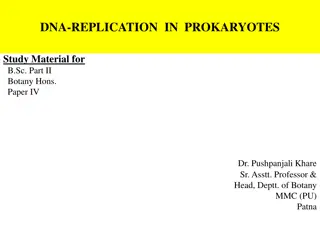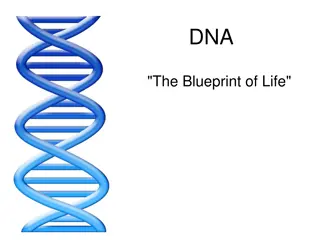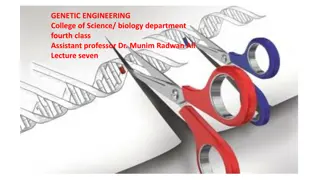Understanding DNA Mutations and Their Types
DNA mutations are changes in the DNA molecule that can lead to permanent alterations in the base sequence of daughter DNA. Causes include uncorrected errors, as well as damage from oxidative deamination, radiation, and chemicals. The types of mutations include point mutations, insertion mutations, d
4 views • 7 slides
Comprehensive DNA Characterization Methods in Molecular Biology
Explore the various techniques involved in the characterization of DNA, including spectrophotometric assay, melting temperature determination, quantitative and qualitative analyses, DNA purity assessment, GC content calculation, and DNA denaturation processes. Learn how to determine DNA concentratio
0 views • 12 slides
Understanding DNA Extraction from Strawberries in Molecular Genetics
In this molecular genetics lesson, students explore DNA extraction from strawberries. The content covers the structure of DNA, nucleotides, and the role of DNA in determining genetic information. Students learn about the components of nucleic acids, DNA functions, and the double helix structure of d
1 views • 87 slides
Understanding the Structure and Importance of DNA
Explore the essential components and structure of DNA, including nucleotides, RNA, and the significance of DNA in carrying genetic information across generations. Learn about the four DNA nucleotides, how mononucleotides are formed, and the discovery of DNA's structure. Dive into base pairing and th
0 views • 30 slides
Understanding the Relationship Between DNA and Protein Specificity
The relationship between an organism's DNA and protein specificity is intricate. DNA encodes the information for the sequence of amino acids in proteins, thereby determining their specificity. This process involves DNA directing the synthesis of specific RNA molecules, which are then translated into
0 views • 17 slides
Understanding DNA Ligation Techniques for Molecular Biology Applications
DNA ligation involves joining DNA fragments to vectors to create new DNA or plasmids. Methods include DNA ligase, T4 ligase, and terminal deoxynucleotidyl transferase. Linkers and adaptors play a key role in DNA cloning experiments by generating sticky ends for DNA cloning. The use of adaptors allow
1 views • 13 slides
Understanding DNA Replication in Prokaryotes for B.Sc. Botany Hons. Students
Study material on DNA replication in prokaryotes focusing on key concepts like semiconservative mode of replication, involvement of enzymes, different models for understanding replication, and the bidirectional nature of DNA replication in prokaryotes. The material covers the process steps including
0 views • 33 slides
Lab 2: DNA Extraction Techniques for Arthropods and Wolbachia
In this lab activity, students will learn how to isolate genomic DNA from arthropods and Wolbachia bacteria. The goal is to transition from fieldwork to molecular biology, utilizing DNA as a diagnostic tool. The activity involves extracting total genomic DNA from identified species and includes pre-
0 views • 11 slides
Pulsed-Field Gel Electrophoresis: Separating Large DNA Molecules
Pulsed-Field Gel Electrophoresis (PFGE) is a technique developed to effectively separate large DNA molecules through the application of an electric field that periodically changes direction. This method, introduced by David C. Schwartz and Charles C. Cantor in 1984, revolutionized the resolution of
1 views • 11 slides
The Intriguing Structure and Functions of DNA
DNA, or Deoxyribonucleic Acid, is a fundamental molecule in living organisms, characterized by its double helical structure consisting of two antiparallel polynucleotide chains. Each strand is composed of nucleotide monomers, comprising deoxyribose sugar, phosphate group, and nitrogenous bases (puri
0 views • 12 slides
Exploring Nucleic Acids: DNA and RNA Structure and Function
Delve into the world of nucleic acids with a focus on DNA and RNA molecules. Discover the fundamental building blocks, such as nucleotides, and the role they play in genetic information storage and cell function. Learn about the unique characteristics of DNA like its double-helix structure and the s
0 views • 26 slides
Understanding Epigenetics: DNA Methylation and Histone Modification
Epigenetics refers to changes in gene expression without altering the DNA sequence. This involves processes like DNA methylation, histone modification, and microRNAs. DNA methylation is controlled by DNA methyltransferase enzymes and plays crucial roles in gene activation and silencing. Histone modi
0 views • 13 slides
Understanding DNA Profiling: Techniques and Applications
DNA profiling, invented by Alec Jeffreys in 1985, is a technique used to distinguish between individuals of the same species based on their DNA. The process involves breaking down cells to release DNA, cutting the DNA into fragments using restriction enzymes, separating and analyzing fragments based
12 views • 23 slides
Exploring the Evolution of Molecular Biology: From DNA Discovery to Genome Complexity
Uncover the fascinating journey of molecular biology, tracing key milestones from the discovery of DNA to the intricate structure of genes and genomes. Dive into historical breakthroughs, such as understanding the role of genes in producing proteins, the double helix structure of DNA, and the comple
2 views • 30 slides
Unraveling the Story of DNA: From Discovery to Structure
Explore the fascinating world of DNA, the blueprint of life, starting from the groundbreaking Hershey-Chase experiment in 1952 to the discovery of its structure by Watson and Crick. Learn about nucleotides, base pairs, and the key contributors like Rosalind Franklin and Erwin Chargraff. Delve into t
0 views • 24 slides
Understanding DNA, Chromosomes, and Chromatin Structure
DNA is made up of genes, chromosomes, and chromatin. Genes carry vital information for protein synthesis, while chromosomes are condensed DNA required for cell division. Junk DNA are non-coding regions, and sister chromatids are identical DNA copies. Homologous chromosomes have matching structures,
1 views • 17 slides
Helix Diagnostics: State-of-the-Art Clinical Laboratory in Michigan
Helix Diagnostics, founded in 2015 and located in Waterford Township, Michigan, is a cutting-edge clinical laboratory offering services such as therapeutic drug monitoring, blood chemistry testing, pharmacogenomics, and molecular pathogen detection. With over 125 employees, they serve a wide range o
0 views • 11 slides
Exploring the Structural Model of DNA and RNA
Delve into the intricate world of nucleic acids, DNA, and RNA through the groundbreaking structural model proposed by Watson and Crick in 1953. Unravel the double helix structure, base pairings, and secondary structures of DNA, alongside the pivotal discoveries by Erwin Chargaff in understanding DNA
0 views • 18 slides
Understanding Recombinant DNA and Gene Cloning
Recombinant DNA is artificially created by combining DNA from multiple sources into a single molecule. This process involves treating DNA with restriction endonucleases, such as BamHI, which cut at specific sites, resulting in sticky ends that can base pair with complementary DNA molecules. DNA liga
0 views • 33 slides
Understanding Sanger DNA Sequencing Procedure
Overview of Sanger (dideoxy) DNA sequencing, involving deoxynucleotides and dye-labeled dideoxynucleotides to image DNA band sizes. The simulation model includes steps like denaturing DNA, annealing primers, and synthesizing DNA chains using dNTPs and ddNTPs. The process culminates in electrophoresi
0 views • 7 slides
Overview of Thermostable DNA Polymerases and Their Properties
Thermostable DNA polymerases play a crucial role in various molecular biology techniques, with Taq DNA polymerase being a household name due to its discovery in Thermus aquaticus. These enzymes catalyze DNA synthesis, require magnesium ions for activity, and exhibit optimal function at high temperat
0 views • 8 slides
Understanding DNA Transformation in Bacterial Cells
DNA transformation is a crucial process in genetic engineering, where foreign DNA is introduced into bacterial cells such as E. coli. This process, known as transformation, involves making the cells competent to uptake DNA through physical and chemical treatments. The uptake of DNA occurs after trea
0 views • 34 slides
Understanding the Structural Elements of DNA in Molecular Biology
DNA, the genetic material of living organisms, consists of two antiparallel polynucleotide chains forming a double helical structure. Each chain is composed of nucleotide monomers, consisting of deoxyribose sugar, phosphate group, and nitrogenous bases (purines and pyrimidines). The backbone of DNA
0 views • 17 slides
Understanding DNA Structure and Replication
Discover the key aspects of DNA, including its structure as a nucleic acid polymer composed of nucleotides and the process of DNA replication. Learn about the double helix structure, base pairing rules, and the semi-conservative replication mechanism. Explore how DNA is synthesized in a 5 to 3 direc
0 views • 18 slides
Understanding DNA: Structure, Replication, and Expression
DNA, discovered by Watson and Crick, stores genetic information in nucleotides consisting of nitrogenous bases, sugar, and phosphate. It forms a double helix with adenine, guanine, thymine, and cytosine bases following specific pairing rules. DNA replication is semi-conservative using enzymes like h
0 views • 35 slides
Understanding DNA Structure: A Comprehensive Overview
DNA, or deoxyribonucleic acid, is a fundamental molecule in genetics. It consists of two antiparallel polynucleotide chains made up of monomer units containing sugars, phosphates, and nitrogenous bases. The structure of DNA includes deoxyribose sugar, phosphate groups, and nitrogenous bases like ade
0 views • 18 slides
Unveiling the Molecular Structure of DNA
The molecular structure of DNA, a double-stranded helical molecule, holds the genetic information in living organisms. Comprised of nucleotides with deoxyribose sugar, phosphate groups, and nitrogenous bases, DNA forms a ladder-like structure. Base pairing, governed by Watson-Crick rules, leads to t
0 views • 11 slides
Understanding Nucleic Acids: DNA, RNA, and Nucleotides
Nucleic acids are essential molecules that store genetic information and aid in protein production. This content delves into the monomeric structure of nucleotides, the differences between DNA and RNA, the unique characteristics of DNA's double helix structure versus RNA's single-stranded form, and
0 views • 11 slides
Understanding DNA Replication Process in Living Organisms
DNA replication is a fundamental biological process where an original DNA molecule produces two identical copies. This process involves initiation, elongation, and termination stages, utilizing replicator and initiator proteins. The DNA is unwound and replicated with the help of enzymes like helicas
0 views • 16 slides
Understanding DNA in Forensic Science: Solving Crimes with Evidence
DNA, or deoxyribonucleic acid, plays a crucial role in solving crimes by providing unique genetic information that can link suspects to evidence, identify victims, and link crime scenes. Factors such as environmental conditions can influence the reliability of DNA evidence. CODIS, the Combined DNA I
0 views • 8 slides
DNA Extraction from Blood: Methods and Protocol
Studying DNA is crucial for disease prevention, diagnosis, and treatment. This guide provides a step-by-step protocol for extracting DNA from blood, involving procedures like cell lysis, protein and RNA removal, DNA precipitation, and final nucleic acid determination. Key steps include using reagent
0 views • 6 slides
Understanding DNA and Genetics: A Comprehensive Overview
Living things store, retrieve, transmit, and respond to information essential for life processes. This encompasses the heritability of genetic traits through DNA and RNA, the discovery of the double helix structure of DNA, and key experiments validating DNA as the heritable molecule. Explore the com
0 views • 30 slides
Understanding DNA, Transcription, and Translation Process
DNA carries genetic instructions in organisms through nucleotide sequences like A, T, C, and G arranged in a double helix. Transcription converts DNA to mRNA in the nucleus, where RNA polymerase copies the DNA template. mRNA, with U instead of T, carries the genetic message. Translation involves ami
0 views • 26 slides
Understanding DNA Structure, Replication, and Proofreading
Exploring the intricate world of DNA, this module delves into the structure of DNA, highlighting nucleotides, nitrogenous bases, and the double helix. It emphasizes how DNA stores genetic information in genes and undergoes replication through a semi-conservative model. The process of DNA replication
0 views • 13 slides
Understanding DNA Fingerprinting and Its Applications
DNA fingerprinting, also known as DNA profiling, is a crucial technique used in forensic labs for identifying suspects or determining paternity. By cutting DNA with restriction enzymes and using gel electrophoresis, DNA fragments are separated according to size to create unique profiles. This highly
0 views • 20 slides
Understanding Different Forms of DNA Structures
DNA can exist in various forms such as single-stranded, double-stranded, and mixed forms. The primary, secondary, and tertiary/quaternary structures play crucial roles in determining the overall structure of DNA. Forms like A-DNA and B-DNA have distinct characteristics and are commonly found in diff
0 views • 57 slides
Understanding DNA and DNA Replication: Key Concepts with Visual Aids
Explore essential terms related to DNA and DNA replication, including chromosomes, genes, nucleotides, double helix structure, hydrogen bonds, and more. Discover the process of DNA replication, involving enzymes like DNA polymerase and helicase, and the concept of semi-conservative replication. Rein
0 views • 13 slides
Understanding Genetics and Mutations
DNA, the building block of life, contains the genetic code of organisms and is made up of nucleotides. Adenine pairs with thymine and cytosine pairs with guanine in a double helix structure, held together by hydrogen bonds. DNA replication creates identical DNA copies, while transcription produces R
0 views • 18 slides
Insights into DNA Replication and Chromosome Structure
DNA replication is a fundamental process vital for the transmission of genetic information. Chromosomes, composed of DNA-protein complexes, store genetic information, and replication involves the synthesis of new DNA molecules. Enzymes play crucial roles in DNA synthesis, and in E. coli cells, repli
0 views • 16 slides
DNA Structure and Replication Overview Test
Explore a comprehensive review test on DNA structure and replication, covering key concepts such as DNA abbreviation, sugar in DNA, bonding in the double helix, nitrogenous bases, base pairing, scientists' contributions, and the double helix model. Test your knowledge with multiple choice, matching,
0 views • 24 slides







































